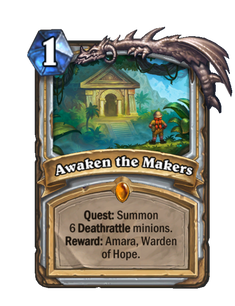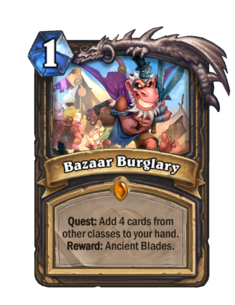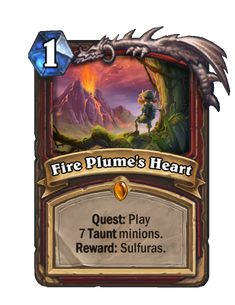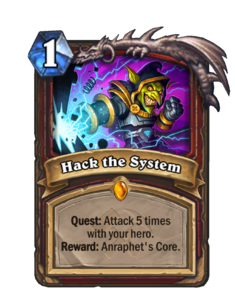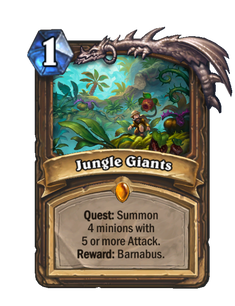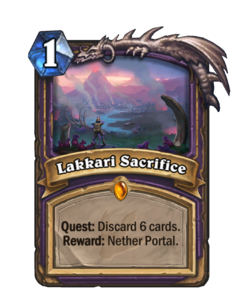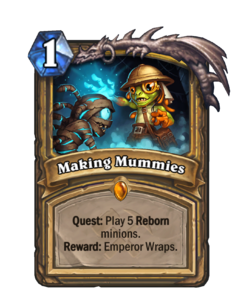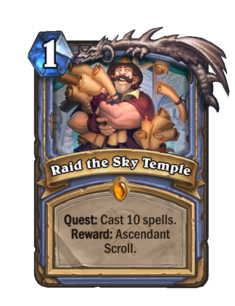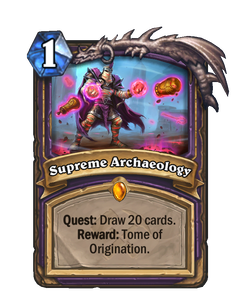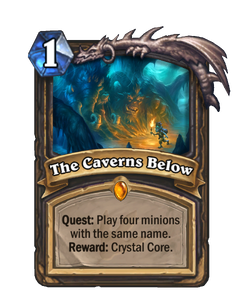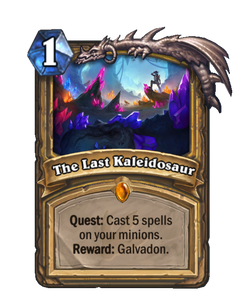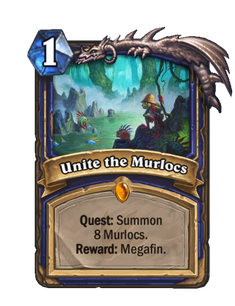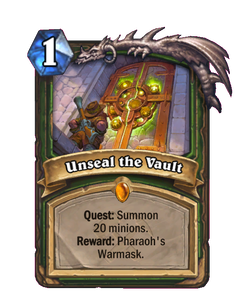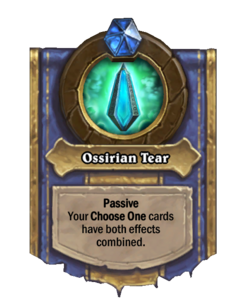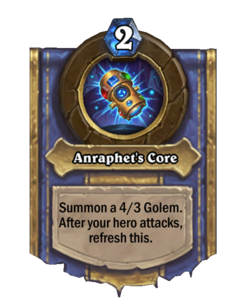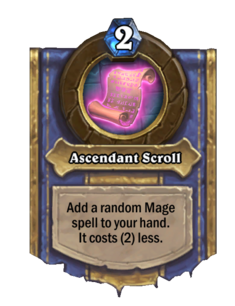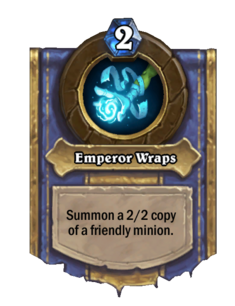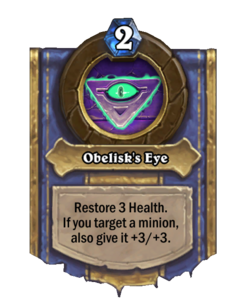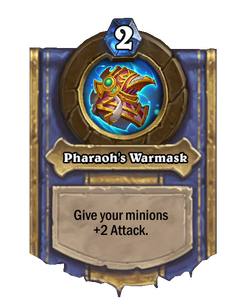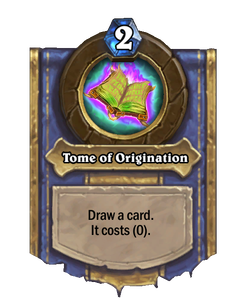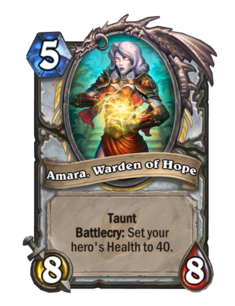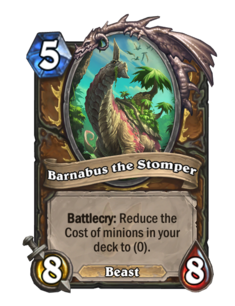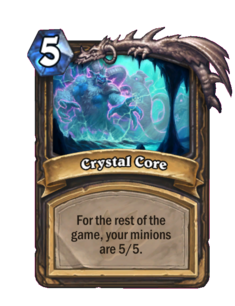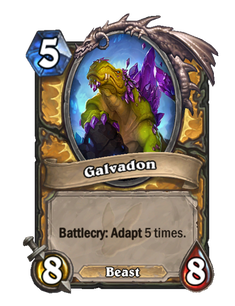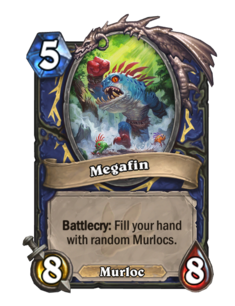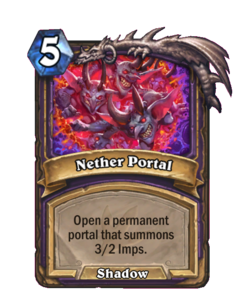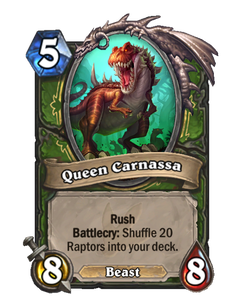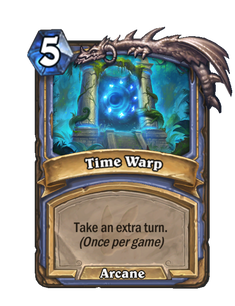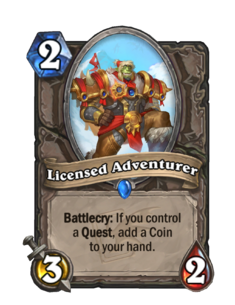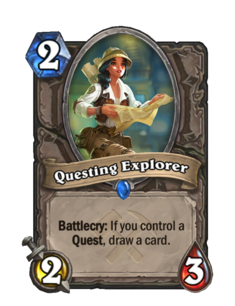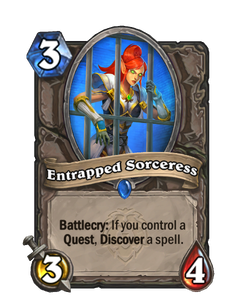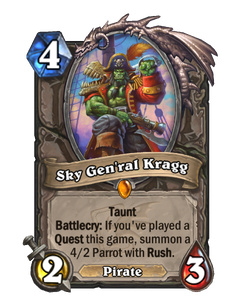Quest (ability)
- Quest
Starts in your hand.
Complete for a reward. - This article is about the ability on certain spells. For quests which reward XP, see Quest.
- For information about specifically Questlines, see Questline.
- For the Quests in Battlegrounds, see Quest.
A Quest is a spell ability and type of spell card which grants a conditional reward. When played, Quests are displayed in the hero zone above the controlling hero's portrait, similar to Secrets. When the condition of the Quest is met, the Quest's reward is given to the player. Unlike Secrets, Quests can be seen by the opponent when they are hovered over, the Quest's progress is displayed to both players, and their conditions are met by the possessing player rather than by the opponent.
Only one Quest can be in play on each hero at any given time.[1] In addition, Quest cards are automatically included in the player's mulligan as the left-most card(s), although the player can choose to replace them.[2][3] All Quests are legendary spells.
Quests were a major new gameplay feature in the Journey to Un'Goro expansion. A second round of quests released with Saviors of Uldum.
Notes[edit | edit source]
- Quests cannot be offered in the Arena.
- Quests cannot be randomly generated by 'outside-of-game' effects,[1] such as from
 Wandmaker,
Wandmaker,  Cobalt Spellkin,
Cobalt Spellkin,  Ethereal Conjurer,
Ethereal Conjurer,  Spellslinger,
Spellslinger,  Babbling Book, Yogg-Saron, or
Babbling Book, Yogg-Saron, or  Nexus-Champion Saraad.[4][5][6] However, they can still be copied by effects such as from
Nexus-Champion Saraad.[4][5][6] However, they can still be copied by effects such as from  Shadow Visions,
Shadow Visions,  Mind Vision, and
Mind Vision, and  Thoughtsteal.[1]
Thoughtsteal.[1] - Unlike Secrets, Quests can be activated during both players' turns. This is irrelevant for Quests that require the player to play cards - which can only be done on the Quest's controller's turn - but it can affect Quests that require summoning minions.
- Example: A shaman has 7/10 progress on
 Unite the Murlocs. Their opponent kills their
Unite the Murlocs. Their opponent kills their  Sated Threshadon, summoning 3 Primalfins for them and completing the Quest.
Sated Threshadon, summoning 3 Primalfins for them and completing the Quest. - Example: A priest has 6/7 progress on
 Awaken the Makers. Their opponent plays
Awaken the Makers. Their opponent plays  Hungry Dragon, which summons a
Hungry Dragon, which summons a  Leper Gnome for the priest, completing the Quest.
Leper Gnome for the priest, completing the Quest.
- Example: A shaman has 7/10 progress on
- Viewing a Quest in the Collection manager will display its reward beside it.
- Quests generate their rewards after the phase in which they were completed.[7]
- It is therefore impossible for an effect that completes a Quest to directly affect the reward in the hand, since the reward would not yet have been generated.
- Example: A warlock plays
 Doomguard with
Doomguard with  Lakkari Sacrifice at 5/6 progress. Doomguard's Battlecry discards two cards from those already in hand, then the
Lakkari Sacrifice at 5/6 progress. Doomguard's Battlecry discards two cards from those already in hand, then the  Nether Portal reward is added to the hand, hence it is not possible for the reward to be discarded via Doomguard.[8]
Nether Portal reward is added to the hand, hence it is not possible for the reward to be discarded via Doomguard.[8]
- Example: A warlock plays
- If the condition for a Quest which gives a card as its reward is met when the owner's hand is full, the Quest completes but the reward is lost. This can happen if a summon effect completes the Quest while the player has a full hand, or if the Quest is completed by playing a card that adds more cards to the hand. Hence, you have to be careful with this, particularly when playing with cards that generate more cards such as using
 Fire Fly with
Fire Fly with  The Caverns Below.
The Caverns Below.
- Example: A mage has 9 cards in hand and 7/8 progress on
 Open the Waygate. They play an
Open the Waygate. They play an  Arcane Intellect which was generated by
Arcane Intellect which was generated by  Cabalist's Tome. They draw 2 cards, then the Quest completes, and the reward is lost since they now have 10 cards in hand.
Cabalist's Tome. They draw 2 cards, then the Quest completes, and the reward is lost since they now have 10 cards in hand.
- Example: A mage has 9 cards in hand and 7/8 progress on
- Because Quests cards are spells, they can be affected by Secrets such as
 Counterspell or
Counterspell or  Mana Bind. Therefore be careful about playing your Quest if your opponent has a Mage Secret active. This could arise in real games using
Mana Bind. Therefore be careful about playing your Quest if your opponent has a Mage Secret active. This could arise in real games using  Kabal Lackey or if you wish to hold on to your Quest, for example
Kabal Lackey or if you wish to hold on to your Quest, for example  Activate the Obelisk to entice your opponent into damaging you.
Activate the Obelisk to entice your opponent into damaging you. - Only one Quest can be in play per hero at a time. Any Quest currently in play must be completed before a second Quest can be played.[9][10]
Quests[edit | edit source]
Rewards[edit | edit source]
The following cards are generated by Quests.
Sources of Quest[edit | edit source]
Quest-generating cards[edit | edit source]
This section lists cards which generate cards that have the Quest ability.
Related cards[edit | edit source]
Strategy[edit | edit source]
Quests are massive undertakings that should not be included in your deck if you are not sure if you can fulfill them. You should only add them to decks dedicated to finishing them. When contemplating building a Quest-deck, ask yourself the following questions:
- How long does my Quest take to complete? This is actually a multi-facet question. Broadly speaking, most Quests take very long. You will only be able to reap the rewards in the late game. Do not let the reward's low mana cost fool you: You will almost never be able to play them on curve; instead, it is usually only in the late-game around turn 10 that you will be able to complete it (though with
 Lakkari Sacrifice it can be completed on turn 4 with
Lakkari Sacrifice it can be completed on turn 4 with  Cataclysm, allowing you to play the reward on curve, and
Cataclysm, allowing you to play the reward on curve, and  The Marsh Queen and
The Marsh Queen and  Unite the Murlocs can also be completed quickly due to the fast nature of its decks).
Unite the Murlocs can also be completed quickly due to the fast nature of its decks).
- How many cards do I need to fulfill my Quest? Depending on your class, your Quest may require you to assemble and play a large amount of cards. Keep in mind that drawing that many cards takes a lot of time and usually prevents you from summoning your reward before reaching the late-game. However, it can range from simply using your hero power (Activate the Obelisk) to playing 7 Taunts (Fire Plume's Heart).
- How long does it take to play these cards? Depending on your Quest, actually playing the cards that cause your Quest to progress may take up an entire turn, while other Quests can be completed much more quickly. The mana cost of your Quest-related cards is a major limitation of how soon you can reap your reward. For example,
 Open the Waygate may force you to generate high cost spells that you can only cast once or twice a turn, whereas
Open the Waygate may force you to generate high cost spells that you can only cast once or twice a turn, whereas  The Marsh Queen can be completed quickly since a total of 7 Mana is actually needed to complete it, or
The Marsh Queen can be completed quickly since a total of 7 Mana is actually needed to complete it, or  Untapped Potential which requires no effort.
Untapped Potential which requires no effort. - How does my reward fit into my mana curve? Of course, once you have your reward, you still need to play it. In some cases, your progress-related cards will curve smoothly into your reward. Sometimes they don't. If not, the benefit of your Quest reward will be delayed by yet another turn.
- How do I make any use of my reward? In some cases, your reward's power may not be obvious at first. While cards like
 Megafin,
Megafin,  Sulfuras and
Sulfuras and  Nether Portal are always useful, cards like Barnabus,
Nether Portal are always useful, cards like Barnabus,  Time Warp and
Time Warp and  Crystal Core require additional setup to provide any benefit.
Crystal Core require additional setup to provide any benefit. - Can I survive with one card less than usual? Quests are always in your opening hand, replacing one of your other cards. They are cards that have no effect on the battlefield at all until you play the reward. Ask yourself if this long-time investment will pay off for you.
The answers depend on the individual Quest and the cards that are required to fulfill it. For more specific advice, consult your Quest's wiki entry.
Design[edit | edit source]
- Journey to Un'Goro
Senior Designer Peter Whalen discusses the design process behind Quests:
- As we figured out the initial story behind Journey to Un'Goro, we realized that the core fantasy had four pillars: dinosaurs, elementals, exploration, and the primal world itself. Dinosaurs and elementals had their own mechanics, so we needed one more that made players feel like they were on an expedition, exploring the awe-inspiring landscape of Un’Goro Crater itself.
- The idea of creating quest cards had been floating around on our team for a very long time. Back when we were first working on Whispers of the Old Gods, one of the designers pitched a new type of secret: Quests. A Quest was only active on your turn, and when you completed its condition, something awesome happened! When we needed a mechanic for exploring a forgotten world to find something truly amazing, these Quests seemed like a natural fit.
- Once we decided to give Quests a real shot in Journey to Un'Goro, we began heavily iterating on them. We started out with the idea that Quests would be Legendary and the rewards would be fantastic—the core fantasy of a Quest is that you work hard and are richly rewarded. As we’ve seen, that core idea carried through to the present with powerful Quest rewards like Amara,
 Nether Portal, and
Nether Portal, and  Megafin—cards we couldn’t make any other way.
Megafin—cards we couldn’t make any other way.
- Basically everything else about Quest cards changed.
- When we started out, we wanted Quests to feel as much like normal cards as possible, which would make them fit into the rules naturally while being easier to understand. The first Priest Quest, for example, said “When this is the only card in your hand, transform it into an Un’Goro pack.” Other Quests looked very similar to the ones that are coming in Journey to Un’Goro, and they had requirements like “play a certain number of minions of a particular type.” We quickly realized that the most fun Quests were the ones that asked you to accomplish something over the course of a game—those paid off the core Quest fantasy the most.
- One of the things we noticed with Quests that transformed in your hand was that they were hugely frustrating for your opponent. From an opponent’s perspective, you had just played an insanely powerful card seemingly out of nowhere. For example, this was the first version of the Priest Quest. To fix that, we required Quests cards to be played, and allowed both players to see their progress. In Un’Goro, Quests will appear around your portrait just like Secrets do.
- From there, we talked a lot about how Quests are played. We tried having them simply play themselves from your deck so they didn’t take up space in your opening hand, but that was a little too powerful. With no risk involved at all, every single deck would play Quests just in case they happened to satisfy the conditions, or simply to thin the deck by one card. On the other hand, having to draw a Quest felt really bad, because you couldn’t make progress on it until you drew it halfway through the game. That’s why we decided to have Quests start in your opening hand.
- Finally, we needed to decide how much mana Quests would cost, either (0) or (1). When they cost (0), playtesting revealed that players would often hold their Quest and then forget to play it before playing the card that triggered it. Making them cost (1) helped to slow the game down a little—letting the moment you played the quest feel more impactful—and required extra strategy around when to play the Quest. We still liked the overall power level the Quests had at (0), so we made the rewards a little better and the requirements a little easier to meet to balance things out.[11]
- Saviors of Uldum
When designing new Quest cards for Saviors of Uldum, the team approached the mechanic in a slightly different way, as explained by Game Designer Puffin:
- When we decided that we wanted to explore Quests again for Saviors of Uldum, we wanted to do them differently than we did with Journey to Un'Goro. The original Quests were more difficult to complete in general and you tended to have to go all-in in your deck build-around for them. Whether or not you were able to complete your quest often determined if you would win the game since rewards for those quests were so powerful the game ended shortly after.
- With the Quests in Saviors of Uldum, we wanted them to be easier to complete, but also have more of a game to play out once the quest was completed. The new Quests will instantly change your Hero Power on completion so you can immediately take advantage of their effect. We expect these Quests to complete more towards the mid-game than the end game so it will feel more like a second phase of the game with your opponent still having a good opportunity to win.[12]
Trivia[edit | edit source]
- The card art for each Saviors of Uldum Quest depicts a character from the League of E.V.I.L. or the League of Explorers associated with that class.

 Activate the Obelisk:
Activate the Obelisk:  Madame Lazul
Madame Lazul
 Bazaar Burglary:
Bazaar Burglary:  Heistbaron Togwaggle
Heistbaron Togwaggle
 Corrupt the Waters:
Corrupt the Waters:  Swampqueen Hagatha
Swampqueen Hagatha
 Hack the System:
Hack the System:  Blastmaster Boom
Blastmaster Boom
 Making Mummies:
Making Mummies:  Sir Finley of the Sands
Sir Finley of the Sands
 Raid the Sky Temple:
Raid the Sky Temple:  Reno the Relicologist
Reno the Relicologist
 Supreme Archaeology:
Supreme Archaeology:  Arch-Villain Rafaam
Arch-Villain Rafaam
 Unseal the Vault:
Unseal the Vault:  Dinotamer Brann
Dinotamer Brann
 Untapped Potential:
Untapped Potential:  Elise the Enlightened
Elise the Enlightened
Patch changes[edit | edit source]
 Patch 15.6.0.35747 (2019-11-05): Quests now display their reward when viewed in the collection.
Patch 15.6.0.35747 (2019-11-05): Quests now display their reward when viewed in the collection. Patch 8.0.0.18336 (2017-04-04): Added.
Patch 8.0.0.18336 (2017-04-04): Added.
References[edit | edit source]
- ↑ 1.0 1.1 1.2 Mike Donais on Reddit. (2017-03-20).
- ↑ Yong Woo on Twitter (X). (2017-02-28).
- ↑ Peter Whalen on Twitter (X). (2019-07-01).
- ↑ Yong Woo on Twitter (X). (2017-02-27).
- ↑ Peter Whalen on Twitter (X). (2017-02-28).
- ↑ Interview with Mike Donais on Year of the Mammoth - Tempo Storm. (2017-03-01).
- ↑ See this article's Discussion page on Quest reward timing. See the specific Quest pages for the phases in which they could be completed.
- ↑ Doomguard does not discard Lakkari Sacrifice upon completion.. (2017-04-20).
- ↑ Peter Whalen on Twitter (X). (2019-07-01).
- ↑ Peter Whalen on Twitter (X). (2019-07-01).
- ↑ Hearthside Chat: Un'Goro Quests with Peter Whalen. (2017-03-22).
- ↑ Puffin on Reddit. (2019-07-09). Retrieved on 2019-07-16.


